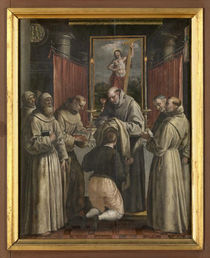The Catholic Defender: Saint Clare of Assisi
- Donald Hartley

- Aug 11
- 2 min read
Updated: Aug 11
Deepertruth with special permission and aid with Franiciscan Media, a great team for the Lord
https://deepertruthdon.podbean.com/e/deepertruth-stand-in-the-gap-with-us-and-saint-clare-of-assisi/

Like St. Francis, Clare was known for her many miracles. Among her most famous feats is using a consecrated Host to ward off invaders. She displayed the Sacrament in a monstrance at the convent gates, and prayed before it; the attackers left.
She was full of the spirit of peace, as well as of fortitude. She was by no means a quarrelsome person, but she was always ready to defend what was good. She was called upon to defend what was good many times in her life, and this required great fortitude.
On Palm Sunday in 1212, she ran away from home and joined the small band of men who were gathering around St. Francis. They welcomed her at the door to their chapel, where St. Francis gave her a rough tunic made of sackcloth and cut off her hair as a sign of renunciation of the world.
The form of life of the Order of the Poor Sisters that Blessed Francis established is this: to observe the Holy Gospel of our Lord Jesus Christ, by living in obedience, without anything of one's own, and in chastity.
One of the more sugary movies made about Francis of Assisi pictures Clare as a golden-haired beauty floating through sun-drenched fields, a sort of one-woman counterpart to the new Franciscan Order.
The beginning of her religious life was indeed movie material. Having refused to marry at 15, Clare was moved by the dynamic preaching of Francis. He became her lifelong friend and spiritual guide.
At 18, Clare escaped from her father’s home one night, was met on the road by friars carrying torches, and in the poor little chapel called the Portiuncula received a rough woolen habit, exchanged her jeweled belt for a common rope with knots in it, and sacrificed her long tresses to Francis’ scissors. He placed her in a Benedictine convent, which her father and uncles immediately stormed in rage. Clare clung to the altar of the church, threw aside her veil to show her cropped hair, and remained adamant.
Sixteen days later her sister Agnes joined her. Others came. They lived a simple life of great poverty, austerity, and complete seclusion from the world, according to a Rule which Francis gave them as a Second Order. At age 21, Francis obliged Clare under obedience to accept the office of abbess, one she exercised until her death.
St. Clare's Feast Day is August 11. She is the patron saint of eye disease, goldsmiths, laundry, television, bicycle messengers, good weather, and needle workers.
In the Convent of San Damiano, Clare practised heroically the virtues that should distinguish every Christian: humility, a spirit of piety and penitence and charity. Although she was the superior, she wanted to serve the sick sisters herself and joyfully subjected herself to the most menial tasks.





















Comments